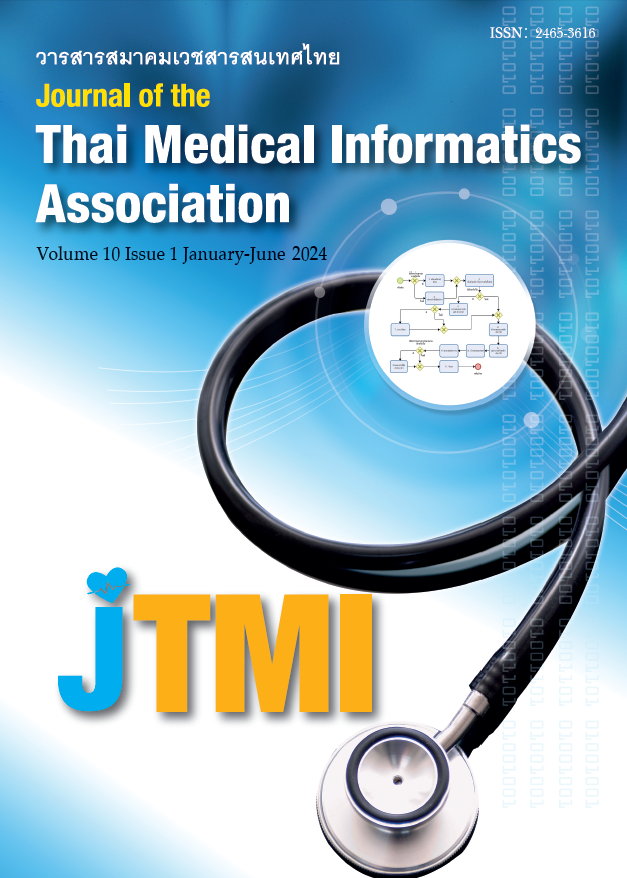Improving registration processes with the use of technology to reduce crowding and waiting time for patients at the registration counters in tertiary care hospital
Keywords:
Registration, Crowding, Waiting Time, KioskAbstract
The process of registration and approval of rights before receiving medical services in the hospital is the important and necessary first step in utilizing healthcare rights and verifying the identity of the service recipients or patients. Due to a high volume of service recipients every early morning, these have resulted in crowded and long waiting time at the registration counters. Therefore, there has been an improvement in the registration processes by Lean principles in conjunction with using technology, such as automated registration or queue management kiosk at three locations in crowded clinic buildings. This has effectively reduced the congestion of service recipients during the period before 8 AM. Prior to the improvement in April 2023, an average of 1,764 service recipients were cleared per day comparing with improving in June, July, and August 2023, the clearance increased to an average of 1,901, 1,990, and 2,133 service recipients per day, with statistical significance (p< 0.05) and did not increase the waiting time even though the number of service recipients increased each month after the improvement, it was 1.3-1.5 times the amount of the month before the improvement. In addition, the number of service recipients using the kiosk has been steadily increasing each month, accounting for 17.4 percent in August compared to July
References
คณะทำงานคู่มือการปฏิบัติงานการให้บริการผู้ป่วยนอก, “คู่มือการปฏิบัติงาน การให้บริการผู้ป่วยนอก (OPD)”, 1ed, สำนักการแพทย์ กรุงเทพมหานคร: 2 July 2022. pp.2-9
R. Yadav, “Reducing Waiting Time of Patients in Outpatient Services of Large Teaching Hospital: A Systematic Quailty Approach,” IOSR-JDMS, vol. 16. no. 11, Ver. III, Nov. 2017, pp. 01-07.
D.P.I.M. Pathirana and N.D. Silva, “Efficient Work place Planning and Designing Strategies to Reduce Waiting Time in the Outpatient Departments (OPD) of Government Hospitals in Sri Lanka,” Proceedings of the 10th World Construction Symposium, Sri Lanka, pp. 404-414, 24-26 June 2022, DOI: https://doi.org/10.31705/WCS.2022.33.
W. Xie, X. Yang, X. Cao, and P. Liu, “Effects of a comprehensive reservation service for non-emer gency registration on appointment registration rate, patient waiting time, patient satisfaction and outpatient volume in a tertiary hospital in China,” BMC Health Serv Res. vol. 19, no. 782, pp. 1-7, 2019.
M. Melesse, M. Woldie, N. Berhanu, and M. Tamiru, “The determinants of patient waiting time in the general outpatient department of Debre Markos and Felege Hiwot hospitals in Amhara regional state,” North West, Ethiopia. vol. 6, no. 5, pp. 17, 2017.
S. T. T. Nguyen, E. Yamamoto, M. T. N. Nguyen, H. B. Le, T. Kariya, Y. M. Saw, et al, “Waiting time in the outpatient clinic at a national hospital in Vietnam,” Nagoya J Med Sci, vol. 80, no. 2, pp. 227-39, 2018.
ประวัติ กิจธรรมกูลนิจ, “การลดระยะเวลาการรอคอย การรักษาแบบผู้ป่วยนอก.” J Thai Med Inform Assoc, vol. 1, pp. 28-31, 2020.
ปอแก้ว เรืองเพ็ง. “การจำลองระบบแถวคอยแผนกผู้ป่วยนอก: กรณีศึกษา คลินิกอายุรกรรม โรงพยาบาลพัทลุง.” วารสาร วิชาการ Veridian E-Journal, vol. 6, no. 3, pp. 834-845, 2013.
ไพรฑูรย์ ทิ้งแสน และ อารีย์ นัยพินิจ, “การกำหนด แนวทางการลดระยะเวลาการรอคอยการให้บริการตรวจโรค ทั่วไปของโรงพยาบาลค ่ายประจักษ์ศิลปาคม จังหวัด อุดรธานี.” NEUARJ NEU Academic and Research Journal, vol. 10, no. 1, pp. 59-72,2020.
ปริตรา มั่นเหมาะ และ ธนัญญา วสุศรี. “การจำลอง สถานการณ์เพื่อลดเวลารอคอยของผู้ป่วย แผนกผู้ป่วยนอก โรงพยาบาลชุมชน จังหวัดสุพรรณบุรี.” ว เภสัชศาสตร์ อีสาน, vol. 15, no. 2, pp. 51-62, 2019.
กฤต จันทรสมัย และ อรอุมา ลาสุนนท์, “การปรับปรุง ผังโรงพยาบาลเพื่อลดระยะทางและลดเวลาในการให้ บริการ.” วารสารวิศวกรรมศาสตร์และนวัตกรรม, vol. 16 no. 1, pp 93-106, 2023
S. Kavanagh and D. Krings, “The 8 Sources of Waste and How to Eliminate Them.” Government Finance Review, Dec. 2011. [online]. Available:https:// www.gfoa.org.






